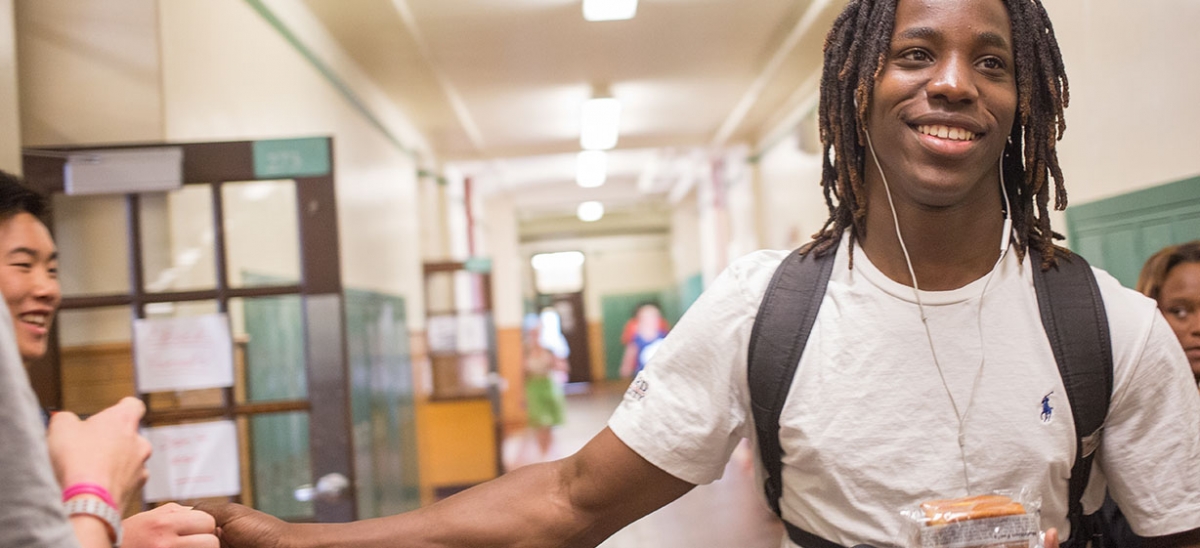
It is 5:30 a.m. on a Thursday in early June—one of the last days of the 2013–14 school year—and Joseph Graham is tired, but awake. It’s about an hour before most of his Allderdice High School classmates in Squirrel Hill have awoken, and Joseph is getting ready to start an hour-long, two-Port-Authority-bus trip across town from his Allentown home near Mount Washington.
“I’m running a little behind,” he says as he walks out the door at 6:35 a.m. in one of Pittsburgh’s most crime-ridden neighborhoods where he lives with his mother and four of his siblings.
He’s headed across town to the school he chose to attend three years ago for its academic reputation and to get him away from his neighborhood school, Carrick High School, where he was convinced he would end up in trouble.
With local rapper K-Hollis playing on his ear buds as he waits for the 54D bus to take him to Oakland for the first leg of his trip, he is not thinking about The Pittsburgh Promise. But Joseph, 17, represents the group of students whose fortunes it was hoped The Promise would change the most: African-American males from poor families in the city’s toughest neighborhoods.
Announced eight years ago, The Promise offers $10,000-a-year scholarships for four years of in-state college education to any graduating senior if they attend 90 percent of their classes and have a 2.5 grade average. The scholarships have two main goals: to keep or attract families to Pittsburgh who would otherwise leave or live in the suburbs; and to act as an incentive to the city’s struggling students to improve their academics and, ultimately, their lives.
Even a promise of $40,000, though, isn’t always enough of an incentive. Last fall, after a series of problems he sums up by saying it was “just stuff at home and in the neighborhood,” Joseph’s grades plummeted—Ds and Fs for a student used to As, Bs and Cs; he fell below the 2.5 threshold he needs. “I was just in a period where I was like, ‘I don’t want to be in school,’ ” he said.
Through tough-mindedness, support from two older brothers who similarly escaped their backgrounds to attend college, as well as participation in the district’s We Promise mentoring program, by the end of the year Joseph was back above the 2.5 line, but not by much.
He knows his future may lie in the balance of which side of that numeric line he lands at the end of the 2014–15 school year. That drives him as much as anything.
He plays football, starting on offense and defense for Allderdice and has some Division II and III colleges looking at him, which might help lift some of the financial burden.
“But I don’t think I’ll be able to go if I don’t get the school money,” Joseph says.
Like Joseph Graham, Saleem Ghubril lives his life in two worlds.
As executive director of The Pittsburgh Promise since 2008, he spends much of his time working with and worrying about kids from the city’s worst neighborhoods, much as he did as founder and executive director of The Pittsburgh Project, a faith-based North Side organization he began in 1985 that also seeks to improve the lives of the city’s poor.
When he’s not spending time with and worrying about those kids, Ghubril is spending time with and worrying about convincing the city’s wealthy individuals, corporations and foundations to kick in enough money to make The Promise a reality for more than just the current generation of Pittsburgh Public School students. While Joseph frets about reaching that 2.5 grade point average before he graduates next year, Ghubril loses sleep over the thousands—or more—of future graduates who’ll benefit if he is able to lead The Promise to its initial fundraising goal of $250 million.
“I’m keenly aware of the heavy lifting that’s before us,” said Ghubril, 53. “I feel its weight and realize its importance.”
After you meet this soft-spoken, ordained minister with the steely determination to help young people, it is the least surprising thing in the world to know he was a friend of Fred Rogers (he spoke at Rogers’ memorial service, bringing many of the mourners to tears).
Like Rogers—who was known to agonize over a single word in a script for “Mister Rogers’ Neighborhood”—Ghubril believes words hold power. “When people ask me what I do now, I still say, ‘youth worker,’ ” he said.
And like Rogers—who showed, as well as told, how people did what they did—Ghubril believes actions can speak louder than words. The North Side home he chose for his family was purposefully alongside the kids and families he helped with The Pittsburgh Project. And when he took the Promise job, Ghubril insisted its headquarters be in a neighborhood where some of its target audience lived. As a result, The Promise is headquartered in the midst of the Hill District. And it is from there that Ghubril worries about the city’s poor youth and wealthy, potential donors.
The Promise’s largest donation—a $100 million matching grant from UPMC—was already on the books when Ghubril took office in June 2008, a year-and-a-half after former Pittsburgh Public Schools superintendent Mark Roosevelt and former Pittsburgh mayor Luke Ravenstahl first announced the creation of The Promise.
No one thought it would be easy finding donors to contribute the $150 million more to ensure that the next generation and beyond will have the support of The Promise. The work has been hard going for a variety of reasons, not the least of which is, as Roosevelt put it, “trying to raise $150 million at the beginning of a recession isn’t easy.”
Still, in his first five years, Ghubril and his team of civic-minded advocates managed to raise nearly half of that—about $73 million. But time is the enemy of an organization like The Promise. As more students have taken advantage of the scholarships, The Promise’s annual expenses have surged, which is good; The Promise is supposed to help those students.
Expenses were about $3 million in 2008, the first year scholarships were awarded to 798 students. In 2012, (the last year that its IRS filings are available), expenses reached nearly $14 million—85 percent of that going to 2,375 scholarships. And if efforts like We Promise are successful, even more students like Joseph Graham will receive Promise scholarships. Ghubril projects that the number of scholarship students will range between 2,100 and 2,400 in any given year and level out at about $16 million in annual scholarship costs. Only students starting with the class of 2012 got the full $10,000-a-year scholarship; earlier classes only got $5,000 per year.
In order to become self-sustaining, however, the simple math means that The Promise must, at some point, be making as much in interest on its reserves as it spends on scholarships and other expenses, or at least come close as new donations continue to come in.
That appears far from happening for now.
At about the time that Ghubril and other Promise leaders were announcing in April 2013 that they would try to raise the remaining $90 million in two years, they knew that in 2012, for the first time in The Promise’s short history, they spent more in the prior year than they took in.
In 2012, with nearly $12 million in contributions (less than half the amount it raised three years earlier) and $1.7 million in investment income, The Promise spent about $17,000 more than it took in, and year-end net assets dropped slightly to $53.1 million. (Through 2012, The Promise spent about $44 million on scholarships and operational expenses. But the expenses already paid plus current assets don’t total $170 million—the amount the Promise raised by 2013—because some of the money raised, including part of UPMC’s matching grant, is in multi-year commitments and has not yet been paid to the Promise.) You might think a year like 2012 would cause even more sleep loss for Ghubril.
But he says of 2012’s expense and revenue figures: “I stopped thinking of our fundraising in 12-month cycles. I thought that was a weakness in the beginning. But, fundraising is a personal experience. It’s an artful dance.”
Even the seemingly meager endowment earnings don’t worry him. “The endowment is well on its way. We’re investing wisely and carefully. We’re not taking chances. But the money also is not hidden in someone’s mattress.”
To have more money to invest for future scholarships, Ghubril and a team of Promise advocates—50 supporters on committees that are chaired by representatives of the city’s most prominent organizations and companies—pledged to finish what they refer to as the “Phase II” of fundraising.
It is not, as it may seem, because of a “cash flow issue,” Ghubril said. Rather, the hyper fundraising effort it hopes to complete by next year “is to try to relieve our donors of the ask-every-year routine.”
Before they began knocking on doors, the three committees The Promise established—Institutional, Individuals and Grassroots—drew up a list of 350 prospective “major” donors who might be able to make donations of $100,000 or more.
The Promise also came up with several new enticements: offering to let a donor name a Pittsburgh school for a $30 million to $99 million donation; naming an endowed chair of The Pittsburgh Promise Executive Director for a $10 million to $29 million donation; and even name a school library, lab or auditorium for a $5 million to $9 million donation.
To shepherd the massive undertaking, The Promise put in place some high-powered figures to run the fundraising committees, including Martin McGuinn, former CEO of Mellon Financial, who co-chairs the Institutional Committee along with former Giant Eagle CEO David Shapira.
“In many ways, this is the most important thing going on in Pittsburgh,” McGuinn said. “Our population was declining and our urban schools were not thriving.”
Last year, McGuinn and his wife, Ann, made the largest personal donation in The Promise’s history of $1 million. His pitch to prospective donors is two-fold: Remind them of the good The Promise already has done and its objectives, but also get donors to think about what happens if McGuinn and his fellow committee members fail to raise the funds.
“The downside is so harsh,” he said he reminds potential donors. “If we don’t fulfill The Promise, it would be extremely negative for the whole community.”
Ghubril does a lot of direct fundraising himself and likes to use an acronym to describe his approach. “Fundraising requires GAS. That’s Grit—the hard work that goes into preparing to approach a donor; Art—being able to relate the stories that explain what we do; and Science—showing them the research and data analysis we’ve done.”
Before he even gets to that, though, every presentation begins with “Please” and ends with “Thank you,” after a reminder to himself that “no one owes you anything, and anything anyone gives you is a gift of grace.”
How has this approach been working?
By Ghubril’s count, pretty well. Not counting the roughly $13 million The Promise raised over the last year, he said The Promise has “high confidence” of $7 million in additional contributions, and “very substantial conversations with major donors” equal to about $30 million to $40 million. “So really we have about $35 million to go,” he said.
Acknowledging that there has not been a spate of large Pittsburgh Public School alumni donations, The Promise recently provided a subtle fundraising reminder by depicting some of its most famous alumni on the cover of its spring “ideapod” magazine, including Andy Warhol, Gene Kelly and Helen Faison next to the title “Our Schools/Our Inspiration.”
And Ghubril has been contacting more national organizations, including, eventually, the Carnegie Corporation of New York, funded by the steel magnate who made his fortune largely in Pittsburgh. “I’m researching now how to approach them,” said Ghubril, who added that when The Promise reaches its initial $250 million goal, he will leave his post.
The Promise has had naysayers since the beginning who either did not think that such a program could help attract or keep residents in the city, encourage the city’s underperforming students to change their ways or raise the money necessary to fund such a program for generations.
“No doubt some of the students receiving the program’s scholarship money have benefited,” wrote Jake Haulk, president of the Allegheny Institute for Public Policy, in a July 2013 Policy Brief. “But if the program was ever going to be successful in its stated purpose, there should be convincing evidence by now.”
In the brief, Haulk, the most regularly vocal critic of The Promise since its inception, cited a continuing decline in school population and test scores in Pittsburgh Public Schools, and again called for repurposing The Promise money into scholarships for students to go to private elementary and high schools instead of the city public schools.
Ghubril and other Promise supporters, strongly disagree. “I don’t know if there were bets on the table early on if we could raise all the money necessary,” Ghubril said. “But here we are six years later with a fairly substantial track record, positive outcomes, $173 million raised and more to come.”
He points to the city’s stabilizing population the last three years, increases in the Pittsburgh Public Schools’ kindergarten enrollment for two straight years, an improved graduation rate (from 63 percent in 2007 to 69 percent in 2012) and an increase in the percentage of graduating seniors who attend post-secondary education the first two years after high school (from 58 percent in 2005 to 68 percent in 2010). For African American males like Joseph Graham, who will be a senior next year at Allderdice, numbers also have improved, though not as much as anyone would like.
In 2007, the last graduating class before The Promise began, only 11 percent of the schools’ African American males attended post-secondary education. That improved to 15 percent by 2010.
The We Promise program that Joseph is part of also seems to be having an impact. In 2012, the year before the We Promise mentoring program began, just 18 percent of African-American male seniors were “Promise Eligible.” That jumped to 23 percent in 2013.
The Promise’s broader goals include helping to improve the potential work force in the city and improving neighborhoods and schools.
“At our first Promise board meeting in 2008, I said that ‘failure’ for us is that 10 years will have passed and we will have sent 15,000 kids to college,” said Ghubril. “And if that’s failure, I can still live with that. But I think we’ll help even more than that.”
And according to leaders across the district, the simple idea of The Promise has taken root in a powerful way.
“It’s wonderful to see kids at the elementary level being asked by their teachers: ‘Are you Promise ready?’ ” said teachers union president Nina Esposito-Vigitis. “It’s common language now.”
Pittsburgh Schools Superintendent Linda Lane sees it every time she talks to students about The Promise. “I was at Faison [Elementary] recently and I asked a little girl there to stand up and say what she wanted to be. She was shy, so her kindergarten-aged sister said she’d do it and she got up and said how she wanted to be a teacher and how she was going to go to school with The Promise.”
Joseph Graham has seen his older brother, William, 19, go off to Slippery Rock University last year, and another older brother, Kedron, 22, graduate this year from Indiana University of Pennsylvania, both with help from The Promise.
“I’ve always known about The Promise,” said Joseph. “But seeing that let me know that if I work hard, and do football, I can do it for free. And I know I’m going to do it.”



